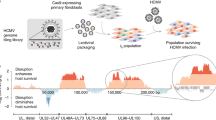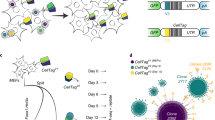Abstract
Here we describe lentivirus-infected cell microarrays for the high-throughput screening of gene function in mammalian cells. To create these arrays, we cultured mammalian cells on glass slides 'printed' with lentiviruses pseudotyped as vesicular stomatitis virus glycoprotein, which encode short hairpin RNA or cDNA. Cells that land on the printed 'features' become infected with lentivirus, creating a living array of stably transduced cell clusters within a monolayer of uninfected cells. The small size of the features of the microarrays (300 μm in diameter) allows high-density spotting of lentivirus, permitting thousands of distinct parallel infections on a single glass slide. Because lentiviruses have a wide cellular tropism, including primary cells, lentivirus-infected cell microarrays can be used as a platform for high-throughput screening in a variety of cell types.
This is a preview of subscription content, access via your institution
Access options
Subscribe to this journal
Receive 12 print issues and online access
$259.00 per year
only $21.58 per issue
Buy this article
- Purchase on Springer Link
- Instant access to full article PDF
Prices may be subject to local taxes which are calculated during checkout




Similar content being viewed by others
References
Brummelkamp, T.R. & Bernards, R. New tools for functional mammalian cancer genetics. Nat. Rev. Cancer 3, 781–789 (2003).
Ziauddin, J. & Sabatini, D.M. Microarrays of cells expressing defined cDNAs. Nature 411, 107–110 (2001).
Mousses, S. et al. RNAi microarray analysis in cultured mammalian cells. Genome Res. 13, 2341–2347 (2003).
Silva, J.M., Mizuno, H., Brady, A., Lucito, R. & Hannon, G.J. RNA interference microarrays: high-throughput loss-of-function genetics in mammalian cells. Proc. Natl. Acad. Sci. USA 101, 6548–6552 (2004).
Yoshikawa, T. et al. Transfection microarray of human mesenchymal stem cells and on-chip siRNA gene knockdown. J. Control. Release 96, 227–232 (2004).
Vanhecke, D. & Janitz, M. High-throughput gene silencing using cell arrays. Oncogene 23, 8353–8358 (2004).
Federico, M. (ed.). Lentiviral Gene Engineering Protocols (Humana Press, Totowa, New Jersey, 2003).
Stewart, S.A. et al. Lentivirus-delivered stable gene silencing by RNAi in primary cells. RNA 9, 493–501 (2003).
Rubinson, D.A. et al. A lentivirus-based system to functionally silence genes in primary mammalian cells, stem cells and transgenic mice by RNA interference. Nat. Genet. 33, 401–406 (2003).
Guertin, D.A. & Sabatini, D.M. An expanding role for mTOR in cancer. Trends Mol. Med. 11, 353–361 (2005).
How, S.E. et al. Polyplexes and lipoplexes for mammalian gene delivery: from traditional to microarray screening. Comb. Chem. High Throughput Screen. 7, 423–430 (2004).
Sarbassov, D.D. et al. Rictor, a novel binding partner of mTOR, defines a rapamycin-insensitive and raptor-independent pathway that regulates the cytoskeleton. Curr. Biol. 14, 1296–1302 (2004).
Naldini, L. et al. In vivo gene delivery and stable transduction of nondividing cells by a lentiviral vector. Science 272, 263–267 (1996).
Inaba, K. et al. Generation of large numbers of dendritic cells from mouse bone marrow cultures supplemented with granulocyte/macrophage colony-stimulating factor. J. Exp. Med. 176, 1693–1702 (1992).
Acknowledgements
We thank S.A. Stewart (Washington University; St. Louis, Missouri) for the gift of LKO.1 puro; C. Dillon (Massachusetts Institute of Technology, Cambridge, Massachusetts) for the gift of Lentilox 3.7-CMV-RFP; and N. Hacohen (Massachusetts General Hospital; Boston, Massachusetts) for the gift of LKO.3 Thy-1.1 and primary mouse dendritic cells. A.E.C. is a Novartis fellow of the Life Sciences Research Foundation; S.M.A. is a Howard Hughes Medical Institute predoctoral fellow. This work was supported by funds from the Whitehead Institute and Pew Charitable Trusts.
Author information
Authors and Affiliations
Corresponding author
Ethics declarations
Competing interests
The authors declare no competing financial interests.
Supplementary information
Rights and permissions
About this article
Cite this article
Bailey, S., Ali, S., Carpenter, A. et al. Microarrays of lentiviruses for gene function screens in immortalized and primary cells. Nat Methods 3, 117–122 (2006). https://doi.org/10.1038/nmeth848
Received:
Accepted:
Published:
Issue Date:
DOI: https://doi.org/10.1038/nmeth848
This article is cited by
-
Virus stamping for targeted single-cell infection in vitro and in vivo
Nature Biotechnology (2018)
-
High-throughput in situ cell electroporation microsystem for parallel delivery of single guide RNAs into mammalian cells
Scientific Reports (2017)
-
High-throughput and combinatorial gene expression on a chip for metabolism-induced toxicology screening
Nature Communications (2014)
-
Optimizing cell arrays for accurate functional genomics
BMC Research Notes (2012)
-
Life on a microarray: assessing live cell functions in a microarray format
Cellular and Molecular Life Sciences (2012)



